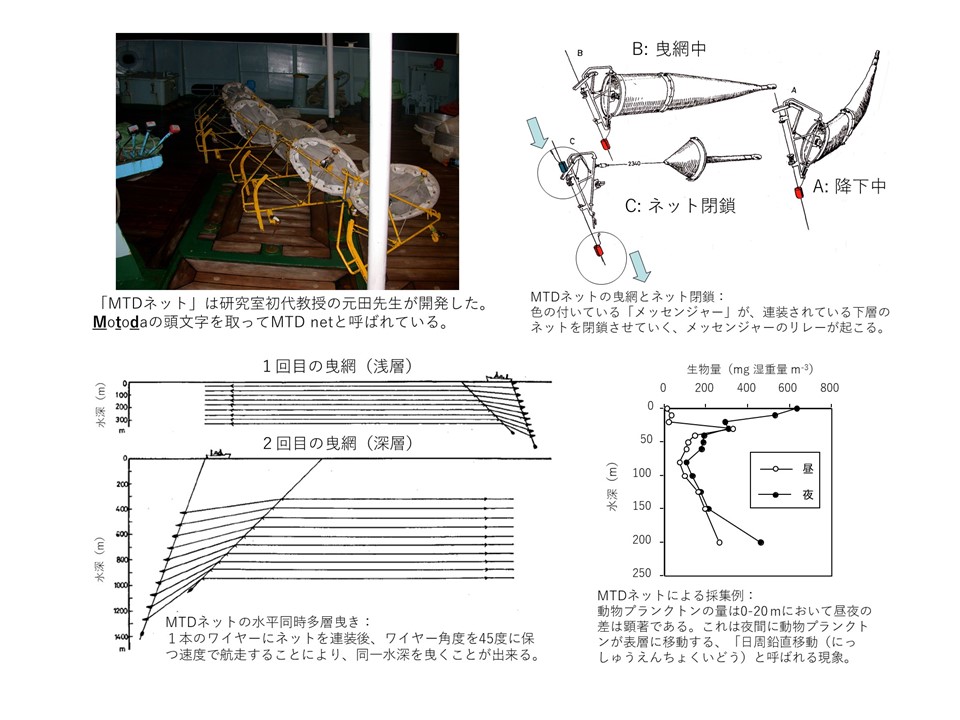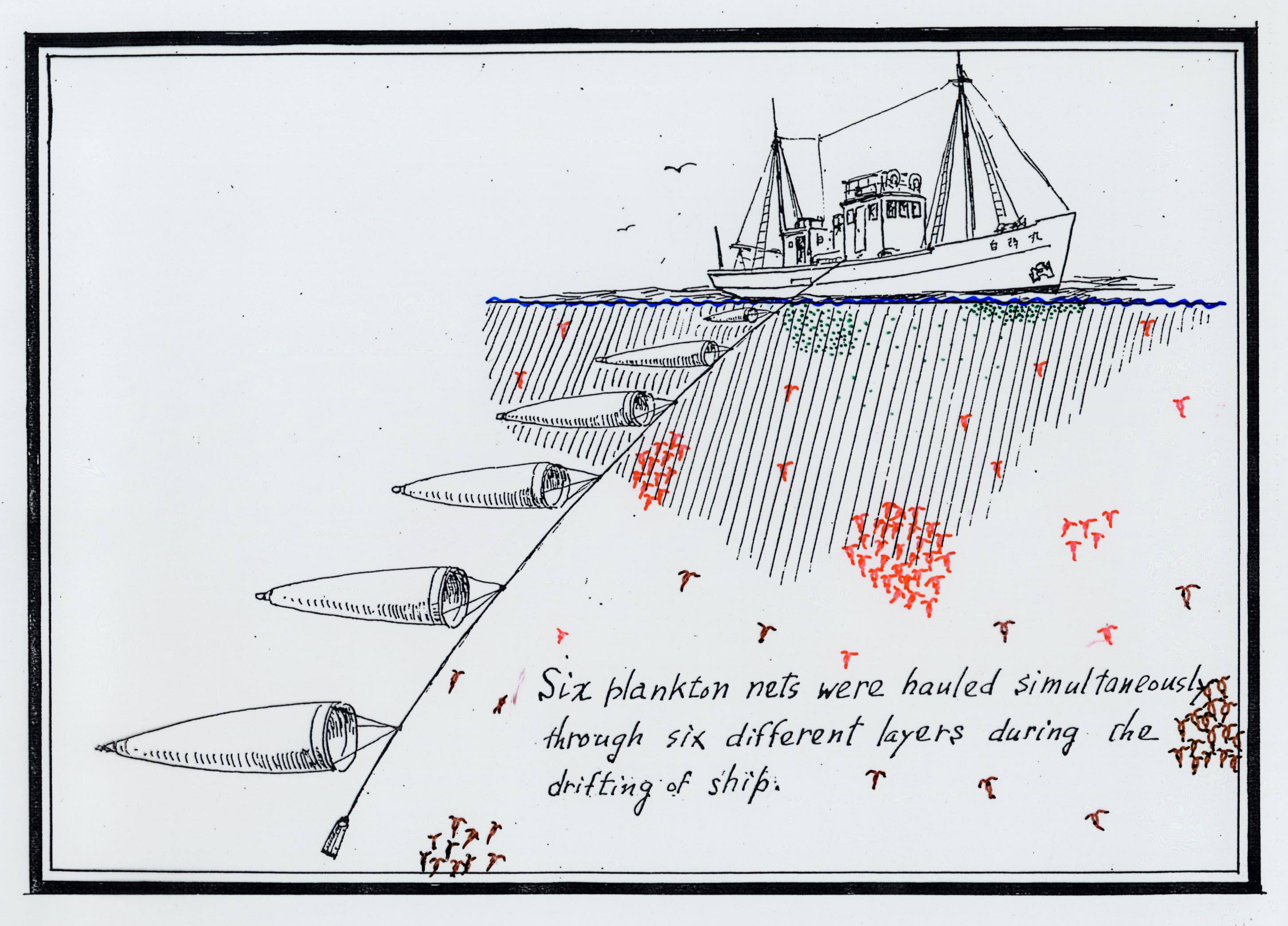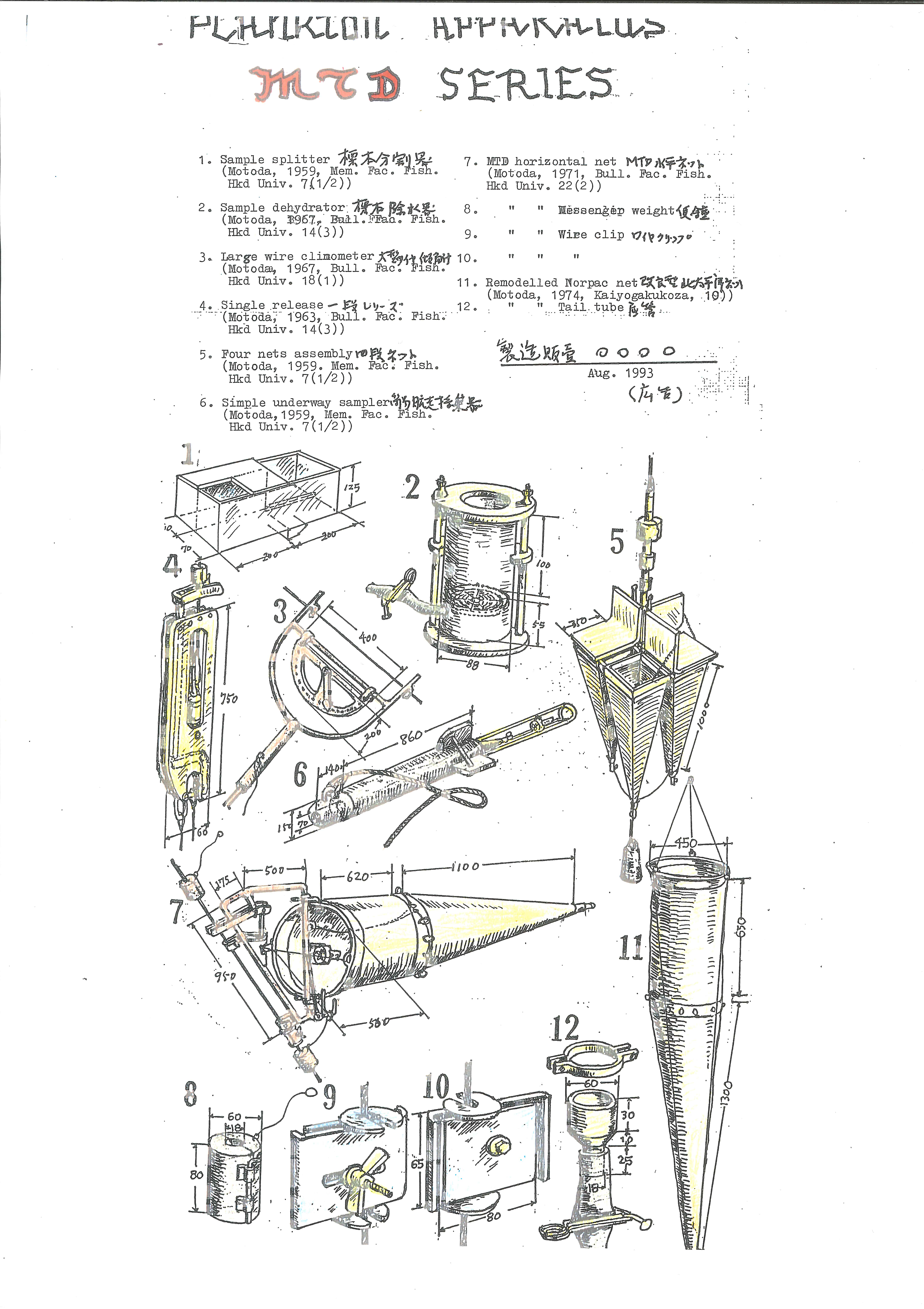MTD Horizontal net
Topic outline
-
A closed net for marine zooplankton that can be horizontally towed to collect plankton at any depth.
After attaching several nets to a single wire extending from the vessel, the vessel is slowly sailed and the wire angle is maintained at 45 degrees, so that several attached nets are towed horizontally and simultaneously in multiple layers at a given depth (Fig. 1).
By dropping a messenger (a weight that falls through the wire) through the wire, the triangular frame and net ring of the MTD net are separated, and the wire that connects the triangular frame and net ring and wraps around the outside of the center of the net is squeezed to close the net. This structure ensures that the plankton collected up to that point are not lost and collected.
It is characterized by its ability to simultaneously collect stratified samples of zooplankton in the ocean from multiple layers, without the use of electrical signals, but only by means of a single wire with a mechanical mechanism.

(upper left)
“MTD net” was developed by Dr. Motoda, the first professor of the laboratory.
It is called MTD net after the initials of Motoda.
(upper right)
Towing and net closure of MTD nets:
A relay of messengers occurs, with the colored “messengers” closing the lower net that has been strung together.
(lower left)
First tow (shallow layer)Second tow (deep layer)
Horizontal simultaneous multi-layer towing of MTD nets:
After a series of nets are attached to one wire, they can be towed at the same depth by towing at a speed that maintains the wire angle at 45 degrees.
(lower right)Example of collection by MTD net:
The difference in zooplankton abundance between day and night is remarkable at 0-20m. This is a phenomenon called “diurnal vertical migration”, in which zooplankton moves to the surface during the night.
-
459.3 KB PowerPoint 2007 演示文档 Uploaded 26/04/23, 16:06
-
-
Mouse Area: 0.25 m2
Mouth Diameter:56 cm
Mesh size: 335 µm (NMG52) -
The MTD net, officially called the MTD Horizontal net (Motoda Horizontal Net), is a plankton net developed in 1971 by Dr. MOTODA Shigeru to evaluate the depth distribution (vertical distribution) of plankton. He is the first professor of the Flotation Biology, School of Fisheries Science, Hokkaido University.
From the beginning of their studies, plankton collectors used “plankton nets”, which resemble insect nets. Early plankton nets collected planktons by attaching an upward-facing plankton net on top of a weight, lowering it to a predetermined depth, and then hoisting it up. However, this method could not reveal the vertical distribution of plankton in the water. Therefore, various types of plankton nets were made in order to clarify the vertical distribution of plankton.
The MTD net is Japan's leading stratified plankton collection device, and is still commercially available in the 21st century. 1971 was the year when the final form of the MTD net was announced, but the germination of the idea (simultaneous horizontal multilayer towing) can be seen in Dr. Motoda's notes from the 1950s (Fig. 2). The following 20 years can be considered as the years of repeated trial and error and testing in order to realize the idea.
Dr. Motoda was a pioneer in the field of plankton research in Japan by developing and publishing a variety of other plankton collection and analysis instruments. Many of the plankton collection and analysis instruments that Dr. Motoda published have been commercialized and are commercially available (Fig. 3). Among these, the “Motoda plankton splitter”, which splits immersed plankton samples in half, is now widely used around the world.
The laboratory of Flotation Biology in the School of Fisheries Science, Hokkaido University, where Dr. Motoda served as the first professor, was the first university laboratory in Japan to be named after “flotation biology”. This tradition has been carried on in the current Marine Biology and Biodiversity (Flotation Biology), Faculty of Fisheries Science, Hokkaido University.


-
491.3 KB 图像(JPEG) Uploaded 26/04/23, 16:06
-
2.1 MB 图像(JPEG) Uploaded 26/04/23, 16:06
-
-
Dr. MOTODA Shigeru contributed greatly to the development of plankton research in Japan by teaching many students at the laboratory of Flotation Biology, Fisheries Science, School of Agriculture, Hokkaido University (in Sapporo) and the Flotation Biology, School of Fisheries Science, Hokkaido University (established in Hakodate in 1950), founding the Japan Plankton Research Association (now the Japanese Plankton Society) in 1952, and serving as its first president (Fig. 4).
After retiring from Hokkaido University in 1971, he taught at the School of Oceanography, Tokai University until his death in 1995 due to kidney failure.
Dr. Motoda has developed many instruments for plankton research (Fig. 5) with his outstanding ideas and artistic sense. The essence of the instruments developed by Dr. Motoda is that they are simple machines that work reliably, and they are used in various ways in plankton research today.


Among the plankton research instruments that Dr. Motoda has made, the most famous and still commonly used are such as:
・NORPAC net(North Pacific Standard net)
・Motoda Plankton Splitter
・MTD Horizontal Net(MTD net)
・Aspirator for wet weight
・angle board
Laboratory logo (left) and signboard (right) designed by Dr. Motoda
-
-
1.3 MB PowerPoint 演示文档 Uploaded 26/04/23, 16:06
-
-
YAMAGUCHI Atsushi
Area of Plankton, Marine Biology and Biodiversity
Faculty of Fisheries Science, Hokkaido University
